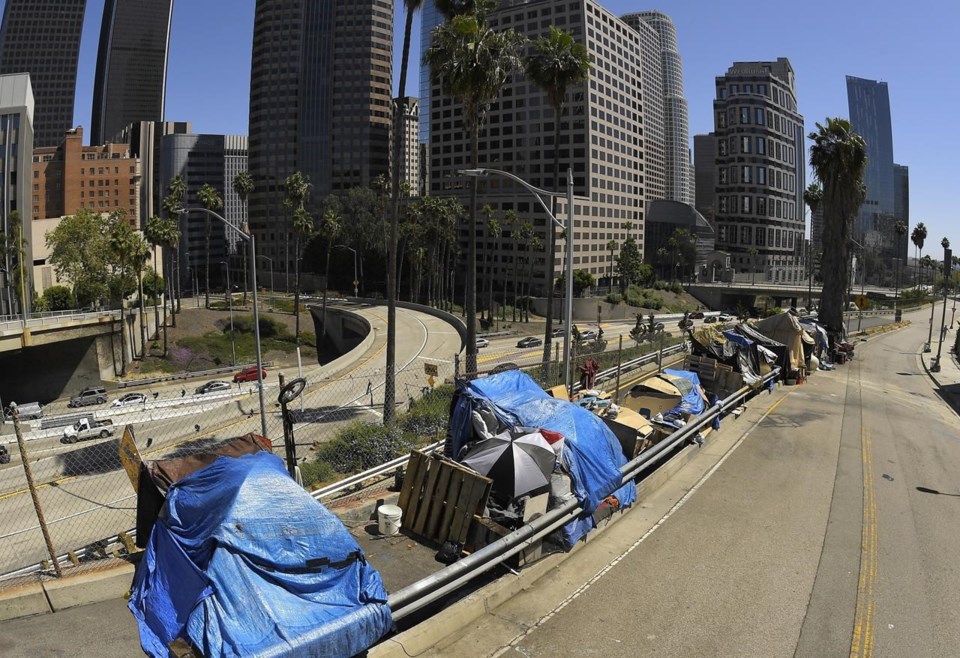LOS ANGELES (AP) — The number of homeless residents counted in Los Angeles County increased again but at a much slower pace than in previous years, according to figures released Thursday that show that more people left the streets for shelters.
The federally required tally conducted in late February found 69,144 people were homeless on any given night in LA County, a 4.1% rise from 2020. About 42,000 were within the city of Los Angeles, where public frustration has grown as tents have proliferated on sidewalks and in parks and other locations.
By comparison, the county saw a 25.9% rise in the homeless population between 2018 and 2020, said Kristina Dixon, acting co-executive director of the Los Angeles Homeless Services Authority, or LAHSA.
“While it is too soon to know what this year's count results will mean long term, the numbers are suggesting there was a flattening of the curve or the percent increase of people experiencing homelessness is shrinking," Dixon said.
However, it also could also reflect the impact of a winter COVID-19 surge that made it harder to count homeless residents, especially young people and families, Dixon said.
LA County is the nation's most populous, with about 10 million people. More than 1 in 5 of all homeless people in the U.S. live in the county, based on the latest federal tally that found 326,000 homeless people nationwide.
The crisis is most apparent in downtown Los Angeles, where thousands of people live in makeshift shanties that line entire blocks in the notorious neighborhood known as Skid Row. Tents regularly pop up on the pavement and parks outside City Hall and homelessness is a major issue in the mayor's race. Encampments also increasingly are found in suburban areas and under freeway overpasses.
Volunteers with LAHSA fanned out across the county in February for the effort's main component, the unsheltered street tally. The so-called point-in-time count took place over three days but results weren’t released until they were validated by the U.S. Department of Housing and Urban Development, or HUD.
Among other findings, nearly half of homeless people in the count identified as Latino, which is in line with the county's overall Hispanic population, while 39.5% reported serious mental illness or substance abuse, which was lower than the national average, Dixon said.
Congress requires the tallies every two years and uses the information to distribute resources for homeless services. However, HUD granted an exemption for the count in 2021 because of the coronavirus outbreak and kept federal funding in place.
California has an estimated 161,000 homeless residents, the most in the U.S. Democratic Gov. Gavin Newsom, facing token opposition as he runs for reelection this year, has budgeted record sums to combat homelessness that pervades all of the state’s major cities and many smaller communities as well.
Newsom is expected to sign a bill that will establish a controversial California court program to steer homeless people with severe mental disorders into treatment. Lawmakers gave the measure final approval last month, despite objections from civil liberties advocates who fear it will be used to force unhoused residents into care they don’t want.
The county and city of Los Angeles have spent tens of millions of dollars under federal programs to provide shelters and permanent housing to the homeless population. Molly Rysman, LAHSA's acting co-director, said that work has paid off, but acknowledged residents might not believe it when they see the sagging tents, rusting RVs and makeshift shelters that have become familiar sights from Hollywood to the San Fernando Valley.
“The streets still look pretty bad," Rysman said. Part of the reason, she said, was that the homeless camps were allowed to remain during the pandemic so residents could shelter in place, and people living there also accumulated more items. But the count found there were fewer individuals living in each tent or RV than before the pandemic.
The result, Rysman said, is a “bit of a disconnect” between the number of people counted and the amount of encampments filling neighborhoods.
LAHSA officials said additional funding and efforts to shelter people were effective, with more than 86,000 rehoused in the past four years. Programs such as Project Homekey, which moved people from the streets into converted hotels, have increased the number of available shelter beds by 70% from 2019 to 2022, according to Dixon.
But the county is suffering from a drastic shortage of affordable housing that exacerbates the problem, she said.
In addition, advocates say, government programs that offered tenant protections, financial assistance and investments for housing and services during the pandemic are ending or will end soon, which could drive more people onto the street.
David Smith, director of litigation at the nonprofit Inner City Law Center that focuses on housing issues, said if Los Angeles doesn't make permanent the temporary rent forbearance rules and eviction protections, the city could see another “wave of homelessness,.”
"The protections against evictions will go away, but you’re still carrying this massive rent debt that you’ll be owing down the road," Smith said. “Many, many people are all of a sudden going to be ripe for eviction.”
Rysman said LA city and county also need to expand supportive services and permanent housing for homeless people.
“The biggest factor driving homelessness is that housing is unaffordable for just about everyone," Rysman said. “To fix this, we need to increase our housing supply across the county by adding more than 800,000 units over the next eight years."
She said that figure was the target included in the Regional Housing Needs Assessment plan, a periodic housing growth program required under state law.
___
Associated Press writer Robert Jablon in Los Angeles contributed to this report.
Christopher Weber, The Associated Press



